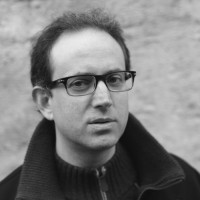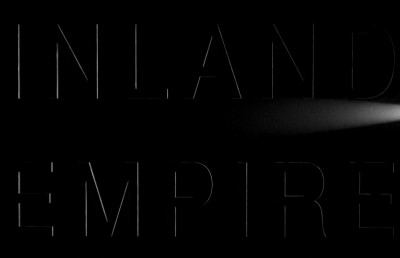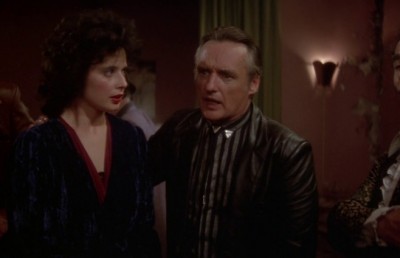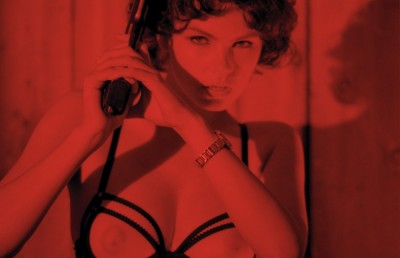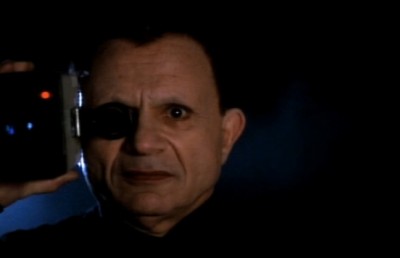Roundtable on David Lynch’s Inland Empire, Part 1
The Independent Spirit
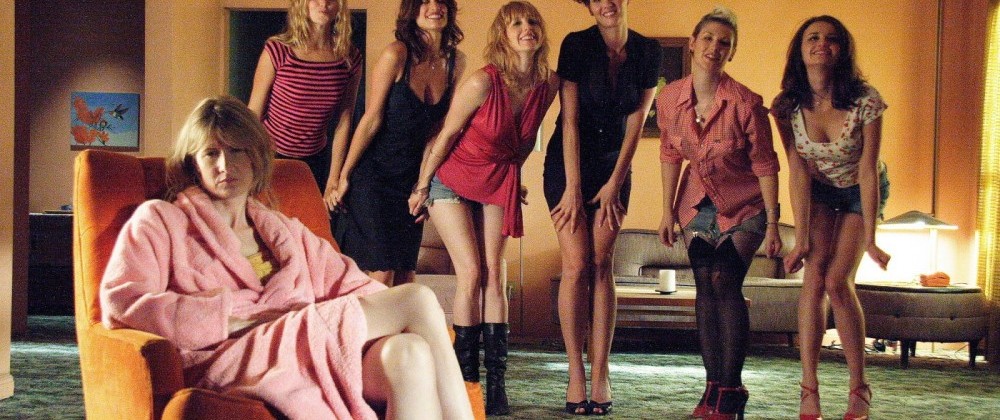
Peter Rist: This is a roundtable, or more accurately an oblong table, with two huge David Lynch experts: Donato Totaro,..
Donato Totaro: Don’t know if I’m an expert…
PR: …Randolph Jordan, and a wildcard Peter Rist.
DT: Guess who the dissenting view is going to be?
PR: Well no, it’s not dissenting, just different. Less expert.
DT: Less effusive.
[Laughs all around]
THE INDEPENDENT SPIRIT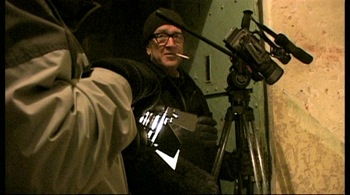
PR: So I guess we could start by talking about what the film is actually like. Well I was just thinking, for a start, that the film is pretty much self-distributed by David Lynch and he’s obviously worked on a very low budget, so it reminds me a bit of the way that Jean-Luc Godard used to work, you know this experimental filmmaker who knows he has a limited market. A friend of ours, Colin Getty, is distributing this in Quebec and the rest of Canada and he doesn’t normally distribute films, so its very much like a cottage industry kind of thing, so I like that about it.
DT: I thought it was interesting in terms of the budget as well. The first time I saw it I was expecting it to be a very small film. I know it’s a small budget but yet it feels like a big budget. When you watch the credit sequence, the number of people that worked on the film is way more than you’d expect from a low budget film. It’s also striking in terms of how many location changes there are. There are quite a few changes in location and different sets, at least 8 or 9 or 10 maybe, and I think that’s one of the more interesting things about the film that we can talk about later is the way he uses sets. So when you say it’s a small budget film, what does that mean aesthetically for the film? Maybe the making of it was small budget?
PR: Right, well, it’s not so much that it’s small budget but it’s the way it’s making do, and this traveling around idea and appearing in different countries over a fairly long period of time sort of reminds me of Orson Welles making The Trial and the kind of situation he was in when he was forced to improvise in terms of how he makes it. So, you know, I think there’s a connection there. It’s definitely very different in the way it was made than other films.
DT: And it’s clearly the film where he has control from beginning to end. So I don’t know how that shapes the film in relation to his other films. Does it feel like he clearly hasn’t compromised anything in terms of what he wanted to do?
Randolph Jordan: I mean, he would save quite a bit of money not having to use film and also rent those cameras…
DT: …or pay people what they’re worth…
RJ: …and that too. And Lynch is the kind of person that people would sign on for at much less their ordinary pay, like Travolta and so forth did with Tarantino on Pulp Fiction which they did for almost nothing, but which of course made them all millions in the end indirectly. I think Lynch has that same status where people will sign on for the pure creative joy of working with him.
PR: Well it’s like him and I guess Laura Dern. If there’s a co-author it’s her because she’s in it from the word go, wanted him to do it and stuff.
DT: Do we know what the budget is?
RJ: No. But I’m sure it’s less than his other films. It has been well known since Blue Velvet that he’s had final cut on all his films, yet he still has to compromise when he wants to do something and the producer says they can’t afford another day with the crew etc. There are always compromises all the way. And that’s the most significant effect of shooting digital on Inland Empire; it’s not so much the look of digital itself, but the freedom to do what he wanted and to shoot in the manner that he wanted and over the period of time that he needed.
PR: A lot has been said about American independent films but this is truly a sort of independent film. In fact, other directors like Jim Jarmusch and Gus Van Sant, even Woody Allen, these directors now are getting most of the funds for their films from France and Britain and other places. So are they even American films? That seems to be the direction that US auteur filmmakers are having to go. Their films are actually more European than American in terms of the support that they’re getting. So Lynch is the most extreme example of this in terms of that way of going, taking that route.
DT: This has Studio Canal behind it from France.
PR: Yeah. Jim Jarmusch’s last film was Studio Canal. The kind of Cannes crowd, the filmmakers that Cannes likes, the French institutions support their films as well. This is kind of interesting. To me they’re not really American films. And then you have someone like Wong Kar Wai making an American film. It is an American film, shot in America.
RJ: The new one? Have you seen it yet?
PR: Well no, of course I haven’t because it just opened at Cannes last night!
DT: You haven’t seen it yet? [Laughing.]
PR: No, it sounds pretty bad but we’ll wait and see I guess.
[link to review of film in question, Blueberry Nights]
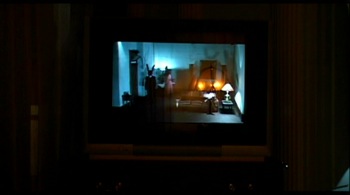
PR: Also interesting is that it’s not HD, you know, it’s almost like low definition digital, but it has been transferred to 35 mm, so I’m thinking that what we’re seeing is what is meant to be there. I mean most of the time when you’re watching digital stuff these days, especially if its projected digitally, you don’t know what it’s supposed to look like. So for example, one of the things I picked up very early in the film is this solarization in light areas which is something I complain about when we show films [at Concordia] on DVD, but clearly this is deliberate because one of the texts, one of the things he’s working with, is light. So he’s actually using that low definition effect to aesthetic advantage in the film. The really interesting thing is going to come when the film comes out on DVD, to see if he’s going to go back to the digital source, or if he’s going to transfer from the 35 mm print.
RJ: Yeah, that’s interesting.
PR: I mean there’s this weird thing they did with…
RJ: …??Russian Ark??…
PR: …yeah, it’s ridiculous they didn’t go back to the digital master. Also with the Lars Von Trier film with the musical sequences…
DT: …Dancer in the Dark.
PR: I remember seeing that in the theatre and the musical sequences looked horrible, and I thought, oh, that’s interesting, they’re meant to look horrible whereas normally musical sequences look gorgeous, and that’s the other world and here that’s the opposite. But when you watch the DVD, the musical sequences are like normal musical sequences, they’re rich in colour, saturated, they look good! So now I’m not sure what it is supposed to look like. So that’s why it’s good this has been transferred to 35 mm, because you know that in that process he’s controlling that so we’re getting what it’s supposed to look like. Now when we get the DVD, again he’s going to pay attention to that too, so it’ll be interesting to see if he transfers from the 35 mm print…
RJ: …to maintain that dirty look. Because the first thing that’s going to happen is that everything is going to look a lot cleaner on a smaller screen on DVD…
PR: …if he goes back to the digital master.
RJ: Yeah.
DT: But in terms of the digital technology, maybe we can talk about how it has affected the visual style. I’ve noticed a lot more close-ups in this film than in his previous films, and specific types of close-ups, like the use of extreme close up shots with wide-angle lenses. Having a smaller camera that can move into that space…
RJ: …and really get into people’s faces…
DT: and not feel as intrusive for the actors.
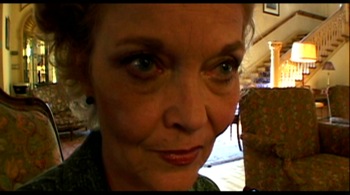
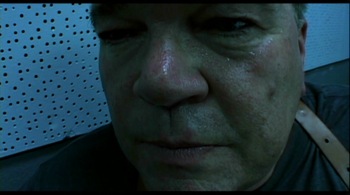
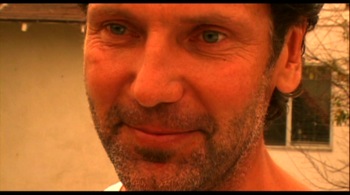
PR: Yeah, well the one thing that was different stylistically was this attempt at doing TV, spoofing TV soap-opera stuff. It seems to me that something was going on there. You mentioned the close-ups. It also seemed as though there was a lot more shot/reverse-shot cutting between characters. It seems to me that was deliberate, and I noticed that a lot more in the beginning of the film than later on. I wonder how much was enforced in terms of the way he was shooting?
RJ: But remember the whole Twin Peaks thing which was actually a soap opera.
PR: Was that filled with close-ups as well?
RJ: Not like this. He has moments, like in Lost Highway as well, where you really have these close-ups, but Inland Empire takes it to another level, as Donato says, where it’s really in your face.
PR: Well that would be interesting, to look at the style of Twin Peaks compared to this. Because why I liked Twin Peaks is that it was so un-television…
RJ: It was so cinematic.
PR: Right.
RJ: So Twin Peaks is like the reverse of Inland Empire; he actually made a soap opera for viewing on TV but shot in a cinematic style whereas here he’s used TV technology and aesthetics to make a film for the theatre.
DT: Although I don’t find that this ever really looks like TV. Are you referring to the rabbit stuff?
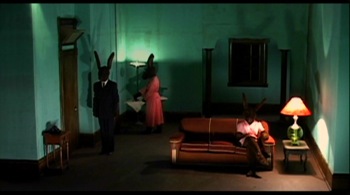
PR: No, not the Rabbit stuff, which is all long-take one set-up.
DT: And the lighting stuff is gorgeous there.
PR: No, I mean the early part of the film with Laura Dern and her husband [and co-star]. I think once they’re on set and shooting the film, it’s sort of setting up relationships between her and men. It seemed to me that there was a lot of shot/reverse-shot, a lot of use of close-ups since that’s what you’re getting in soap operas. You have all these different couples and stuff, I just think he was establishing something, that well, yeah, this person’s life is like a soap opera.
DT: That’s also Hollywood though, classical Hollywood in the 40s and 50s has a lot of shot/countershot stuff.
PR: Yeah, well now Hollywood’s not like that.
DT: No, not now.
PR: Yeah, well obviously it’s not classic Hollywood that he’s referring to. I’m pretty sure he’s not anyway. I mean if he was going to do that he could have done that in some other film or something.
RJ: Well he does a lot more specifically film noir type stuff in Blue Velvet and even Lost Highway and things like that.
PR: Right.
RJ: Yeah, but not so much here I don’t think.
DT: [Back to the point about television], where would you find the television style coming in? Just the fact that [the Polish woman] is sitting in the room watching the
television [at the beginning of the movie]?
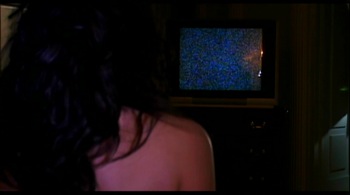
Because [the Hollywood characters] are making a FILM. It’s a film within a film. The TV just seems to be in that moment where she’s in there watching it on TV, and then we get the Rabbit stuff which is not really like TV, only very superficially. Cause no TV just has a long take, static, forever, TV doesn’t shoot that way.
PR: No, I know. That’s why I say it looks to me like it’s really been designed as something weird, where suddenly we’re getting all these shot/reverse shots with situations involving the couple, and that this is like the boring way of doing it, actually because it’s so conventional, so uninteresting. So I think it’s deliberately like that. So I think therefore he’s saying something about the relationship between her and her husband and then her and her co-star. I think it’s especially where they’re first working together with the lothario guy, who she’s been warned against, so you know, this is going to be a soap opera. I didn’t notice that so much once we get into the film, I mean, like I say, where it becomes more traditionally Lynchian, but it’s one of these things that was going on at the beginning, and I thought well this is interesting. You know we actually at times have a soap opera style.
DT: So this is interesting because it’s not interesting! [Laughs]
PR: Yeah! Yeah.
DT: That’s interesting. [More laughs]
SELF-REFLEXIVITY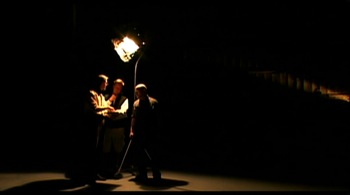
PR: Most people focus on how it’s an incomprehensible narrative, but I don’t think any of us are going to focus on that or be concerned about that. What I really liked about the film is that with this soap-opera referencing in the first hour it seems to me that he’s kind of following on from Mulholland Drive in dealing with performance and with Hollywood but also here with television and just generally with the media. It’s part of the text of what he’s doing is to be self-critical but also critical of the media industries. And that’s because, for me Mulholland Drive was a different kind of film for Lynch because it seemed to me that he was finally becoming self-critical, finally putting his own subject under the microscope and looking at himself and what he is doing and what Hollywood is doing. And whereas Mulholland Drive sustains that throughout, what happened in Inland Empire is that it started out that way, and ended that way, but I’m not sure that he sustained it throughout the film. I think that the narrative, for me, whatever it is, whichever narrative we’re in, tends to take over a bit too much. In other words, I like the beginning and the end, how we kind of break in and out of whatever narrative we’re in, to present this apparent self-criticism of the medium.
But what I was doing with the film, and which is maybe why I should see it again, is to test –like at the beginning I was thinking, wow, this is interesting, he’s got this text of light with all these things going on, but maybe I was over reading into the film. Maybe I was sort of hopeful that he is doing all these different things, and when that’s not followed up, and when we get caught up in the Lynchian stuff and the really weird situations and characters and the look of the sets, when that takes over, what in Lynch’s world is the substance, then I felt a little bit betrayed. But maybe he was just playing with us in the beginning and it kind of comes back to us at the end. But for me I suppose, that reflexivity is what I was most interested in. Maybe that was my mistake to be that interested.
DT: I think the reflexivity is in the film all the way through, I mean, every point there’s always references to the cinema, to light, and to Hollywood itself. I think it’s pretty constant. In the beginning, even though it’s more of a realist narrative, there are still these interjections of oddness –the way the old lady acts, the wide-angle lenses and that kind of stuff– but the reflexivity keeps coming back. Every space she’s in is sort of connected to the theatre. [When she’s about to go up the stairs of the cinema to the back room office, in that kind of interrogation scene], that image there reminded me of the Edward Hopper painting, the usher at the theatre, just the way when we see her looking at the guy that she’s being interviewed by going up the stairs and shot in this blueish light, it’s very much like Hopper. And I know that Lynch is quite a fan of Hopper.
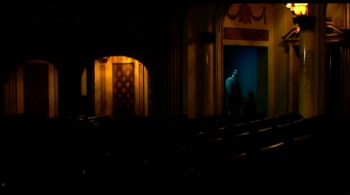
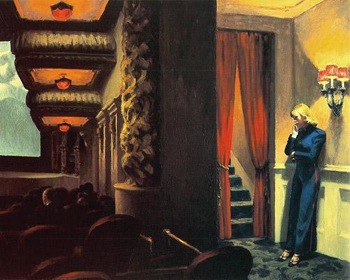
[And later we find another theatrical space connected to the interrogation scene, the nightclub that Laura Dern passes through before heading up the stairs to the office]. Here we see a gesture I think twice if not three times, it felt like a reference to Cocteau, and a kind of a reflection on the digital technology, that shot of the hand leading the camera, leading and pointing, with the red curtain in the back.
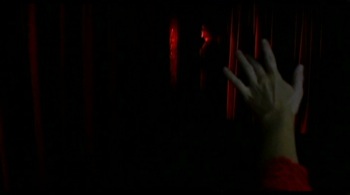
It was such a Cocteau moment, it felt like Orphée, which was all about going into other time zones, and zones period, it felt very Coceteau-esque, that scene.
But in terms of the reflexivity, I was thinking of the way that Hollywood was depicted as well. The scene that I didn’t like so much the first time but liked more the second time, is when she falls down, stabbed, and starts talking to the homeless people.
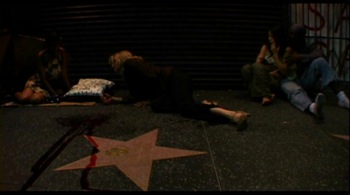
RJ: Yeah, I didn’t like that scene the first time either, but now I like it quite a bit. One thing I really liked about that scene, actually was, on viewing it a second time, knowing that they were going to pull back and reveal that it was a set, I was looking very carefully to see if I thought the whole thing was shot on that set or if they were actually on location. And in fact you can see when they’re shooting back and forth between the characters one side to the other, you can see way into the distance that they are actually on location, they are actually out on the street for all of that scene until…
DT: I like that scene quite a bit where she gets up but she doesn’t break out of the moment, you know even though she’s not dead. The other two actors get up and leave and go for a coffee, but she continues and goes into a theatre, so she can’t get away from cinema.
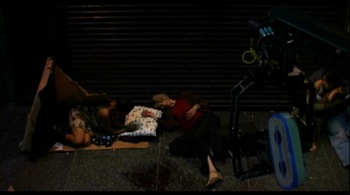
PR: In terms of the social context, the best part of the film is the Hollywood Boulevard thing because most people, myself included, wouldn’t know that downtown Hollywood is like downtown inner cities elsewhere in the US. This is like down and dirty stuff, whereas the Mulholland Drive area is very different.
RJ: It’s very removed.
PR: Yeah, so that is kind of interesting. And that does work because of the stars, you know, in the Walk of Fame.
DT: So is that a political statement, to have these big Hollywood stars names [on the boulevard] and the homeless people there and how she begins to cough up blood directly onto one of the Hollywood stars?
PR: The star is Dorothy Lamour.
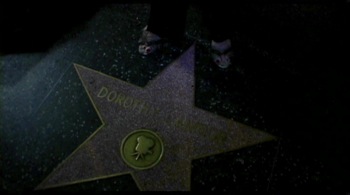
She’s in the road movies which is kind of interesting because that’s a real escapism kind of thing. She was always this grass-skirted kind of character. She’s absolutely Dorothy Lamour, and nobody would ever think she was real. That’s where, I guess, the reflexivity really comes back in, the last hour. Then we go back. For a long time, whatever film set we’re in, we’re in that set and don’t get behind the camera again. So, for the first part of the film we’re always in and out of that, shooting the film, being in the film, you get this confusion between the stories. And you get this gypsy woman telling the story, and gypsies are soothsayers anyway, so she’s telling the future, so all of that stuff that’s going on at the beginning is really interesting. But then you just get into the story, or stories, and we don’t come back out until about an hour from the end, which is that scene on Hollywood Boulevard where we then come back behind the camera again and they’re shooting the scene.
RJ: So in terms of direct reflexivity you lose Jeremy Irons and any notion of that film set and the filmmaking premise. Those things do disappear. And I think you’re right about the way that the film keeps slipping between places, locations…
DT: …and the characters as well, the Devon character sometimes speaks with a southern accent when he’s out of character, and Laura Dern is also sometimes Sue, or Suzanne. So there’s this constant slippage between the different characters even when they’re in the Lynchian section.
PR: Initially when [Laura Dern] is playing the herself, I mean I know she’s not playing herself, but when she’s the [actress character], she uses her own natural accent, and then when she’s in the film she doesn’t, and adapts the more mid-Atlantic Hollywood accent. But then she starts to slip into other characters, the drug-addicted woman on the street character, I guess it gets more complex in terms of Laura Dern because you wonder how many different films she’s in and how many characters she’s playing. So on that level it’s sort of interesting. As well, at the beginning you have the rabbit characters on stage and I just think that’s amazing in terms of us thinking about what we’re doing as an audience. Obviously this is so strange, people dressed up like rabbits and behaving like they’re not rabbits and clearly on a stage, and then we hear the audience laugh…
DT: …the canned laughter…
PR: …and then the reaction of [the Polish prostitute] watching the video and she’s crying. So you kind of get these two opposite reactions by two different audiences and we’re the third audience. So again this is in the beginning of the film and we don’t really return to that again until near the end. And this is what I mean about all these interesting things going on, and I guess I’m more interested in that than I am in the story. And especially when you have the kind of titillation Lynch stuff when you have all the women wearing very little, singing and dancing…
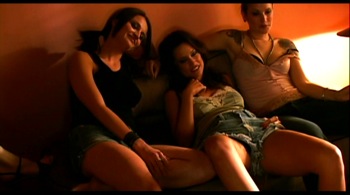
DT: No, I didn’t find that attractive at all…especially when she exposes her breasts, that was horrible!
[Laughter all around]
PR: No, but I mean we’re back in the mainstream world there. At that point we’re just carried away, in a sense like Hollywood films carry us away. I mean it’s weird, right, but it’s very conventional in some ways. He’s not making Hollywood films, but he’s always dealing with Hollywood and Hollywood material and with TV as well. I mean he’s always dealing with relationships. I guess I’m sort of not interested in the tension between the heterosexual couple or whatever, or the triangular relationship. So what’s clever is that he gets audiences involved, even if audiences don’t understand what he’s doing. He is still able to deliver in terms of that sort of tension and interest and seduction. I mean he’s always seducing the audience. I like the bits where we break out of that seduction. For example, in the beginning when you’re on the set of the film and they hear the noise in the background as we gradually understand that that’s Laura Dern out there who is also here, I think that’s very interesting. And of course it comes back into play, this whole idea of mixing, a bit like the end of Kubrick’s 2001 where you’re sort of looking at yourself and you’ve come back to Earth. You’ve gone through space but you’ve traveled through time as well. So this sort of possibility that film can do that, I mean especially through editing, that you can create this impossible space/time situation, I won’t say continuum because it’s not a continuum, so there’s stuff like that which I think is very interesting. As well, like the rabbits scene, I mean you’re on a stage and you never see the audience, you hear the audience, but you’re not really on a stage because you’re in a video monitor, you know. So all of that, that’s the stuff I’m interested in.
DT: But that’s the whole way through the film though.
PR: Well no, I don’t think so…
RJ: I think Peter is right that the first hour is really about them making the film and that reflexive stuff, and we don’t see the camera again or hear Jeremy Irons’ voice until the end. So that specific kind of reference to the film within the film and stuff does disappear in the middle section. One thing I was thinking about [during the film within the film scenes] is I was trying to figure out the purpose, aesthetically, of the digital approach. Wouldn’t it have been better if, when we have moments when we’re inside the film that these guys are making, if they had switched to 35 mm? Because they’re shooting on 35mm.
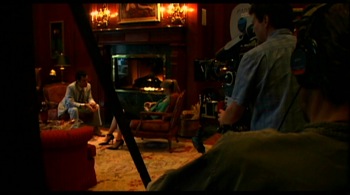
DT: Yeah, their camera is 35 mm…
RJ: … and then when we cut back to seeing the production, you know, back to digital. So that’s what I initially thought. Then I started thinking, if he did that, there would be too much distinction between these two worlds. And actually having things look kind of level the whole way serves this slipping in between [worlds that runs throughout the film]. But then if he’s interested in slipping between, then why do we have these moments where there is a clear distinction, when they’re in costume, they’re on the set of the film, you can tell they’re in the film within the film, and you have this music playing…
DT: One thing Lynch does, and I was wondering if this was bothering you as much as it was bothering me, is that there was no attempt made at all to carry over the illusion of the film within the film. There were scenes where the Jeremy Irons character is filming the two actors in Blue Tomorrow, and there’s all this kind of shot/countershot stuff going on, and then you cut and there’s only one camera [or we only see one set-up]. He could easily have made an attempt at making an illusion of there being [multiple cameras or set-ups]. Did that bother you?
RJ: No, it didn’t bother me. I noticed that too, no only when we’re in the film moments with this shot/countershot stuff, but also sometimes you get this music which sounds like it’s the score for the final film, and so it’s as though we’re watching the final film. But we’re not seeing the entire final film being made, and I don’t think he had to go to the extent of simulating the entire production process because for me that’s part of the slippage. In some moments when they’re in character and they’re acting, we’re not watching them on the sound stage at that moment acting in front of the camera, we’re seeing the finished film complete with the music that would have been composed for it, but they’re not anywhere near that stage yet [during the course of the Inland Empire narrative].
DT: Right. But what I’m saying is that in Hollywood realism there’s at least an attempt made, like if you’re going to go into a flashback you’ll begin with the subjectivity of a character, it’s my flashback…
RJ: Yeah, but that’s one of my favourite things about Lynch is that he doesn’t do that. You don’t know, often, when you’re in a flashback, you don’t know when you’ve slipped into somebody’s dream, he doesn’t announce with the wavy lines or anything like that…
DT: o, I know, I was just using that as an example, for the way that Hollywood will have a pretense to what we believe to be realism, and then move on to the artificiality. Whereas with Lynch, in this film anyway, there’s this level of artificiality all the way through it.
RJ: And that was bothering you?
DT: No, it was bothering me in that particular instance with the film within the film.
RJ: And why was that bothering you? Because we were seeing the finished film but when we cut back to the production, you know, you’re not seeing [the whole production process]…
DT: Yeah, because there were moments like when he was trying to set up the lights which was so funny, with the guy trying to put it up two feet, put it down two feet, and the use of the chair, so there’s some semblance, so maybe at some point he could have at least [gone further with the behind-the-scenes stuff to flesh out the production process in more detail].
FORMAL COHERENCERJ: I think this [media critique/self-reflexivity] is one of the major themes for sure, but I don’t think it’s the only theme. I know [Peter] said that in the middle section it started to slip into an area you didn’t like as much, but that tends to be the part that I like the best. You know, when he sets up a variety of dichotomies between worlds. One is between Hollywood and reality: she’s an actress, she’s playing this role, she’s a real person and there’s sexual tension between her and her co-star, the Justin Theroux character. When is that tension real and when isn’t it? There are a couple of moments when they’re flirting with each other and you’re wondering, is this in the film [they’re making] or is it not? So that’s one dichotomy that he sets up in order to break that boundary down, [and that relates to the self-reflexivity you’re talking about]. But then there’s also this old-world/new-world thing between Poland and the United States. The Laura Dern character is married to a Polish immigrant and there’s this whole idea that her marriage isn’t quite the way she would want because his ideals about the way women are treated are different from the more modern American style. So there’s that kind of thing which is underscored when the Grace Zabriske character tells Nikki the Polish gypsy folk tale, and that the film she’s on might be cursed, and this actually supports the idea that there may be some kind of genuine evil brought over from Poland to the New World that is now affecting the whole thing. So you have that kind of slippage as well that I really like.
To me it’s like a formal exercise, the way Lynch builds associations. I wouldn’t care about that if I didn’t enjoy the experience, so I enjoy the mood of it, and what I like to do while I’m in that mood is see how he builds associations between things. And by setting up all these worlds and then using all these devices to slip between them, which I think are very effective, that’s what keeps me going through the whole movie. The first time I saw it I thought it was much more haphazard, it didn’t really hold together, but it’s coming together much better for me now after three viewings. Even simple little things like when Laura Dern has her hand over her eyes, and she’s in the States, and then she pulls them away and we reveal the Polish street in the winter, and things like that.
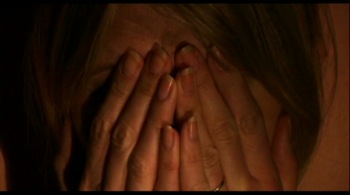
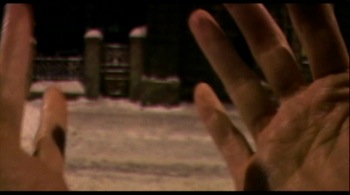
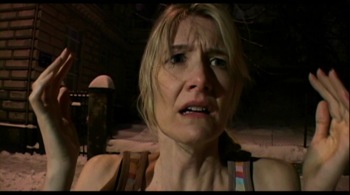
And the way he uses the Smithy’s house set at the beginning of the film when they’re rehearsing, and then Harry Dean Stanton says “who’s that back there?” Then later in the film we get the reverse shot and it’s the Laura Dern character who seems to have been doubled and is looking back; and then she runs back stage and she’s in this house which is on the film set and is looking through the window with Justin Theroux on the other side, then the lighting shifts and all of a sudden she’s looking out onto some sort of suburban back yard.
And the scene on Hollywood Boulevard has one of my favourite slippages too, because [all the women] are down there and they’re all kind of on the street and that sort of funky music [Beck] is playing. Then all of a sudden we go into a close-up on one of the women’s faces, and when we pull back we’re in Poland, the music has stopped, and this more orchestral thing comes in and the tone of the film is changed, they’re all wearing these hats now. It was just a really simple way to transition, you know, to move in and then to move out, and then the background is changed, you know, Last Year in Marienbad type of thing, but he just does that so well throughout the film. I like that a lot.
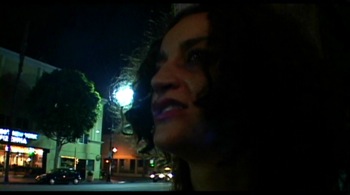
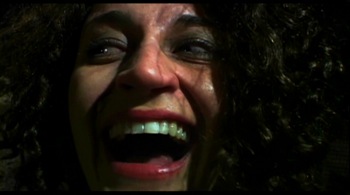
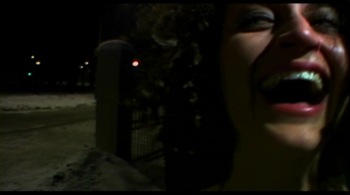
Anyway, it’s that kind of thing that I really like. Just these slippages, sometimes they’re quite simple, but very effective in the way that he puts it all together.
PR: No but that’s interesting. Obviously, you’re saying “well yeah I’m a Lynchian because I enjoy this kind of perceptual play.” What I’m interested in [on the other hand] is what he’s sort of doing with the nature of performance, you know, so you have this very complex level, all these different levels of performance with Laura Dern. So yeah, to me I sort of see this as a Laura Dern kind of David Lynch film and that’s a very interesting thing. So the aesthetic, I guess, I’ve found a great deal of aesthetic pleasure in other films of Lynch, but I guess maybe since Mulholland Drive I’m looking for other things. I mean I actually I need to go back and watch Lost Highway because I only saw that once.
RJ: It’s still my favourite.
PR: Yeah, I have a sense that that might be his best film in terms of how well everything works. But I think with Mulholland Drive and Inland Empire, there’s a sense that he is sort of throwing a lot of stuff out there. You definitely can’t connect all the dots, not just in terms of narrative but stylistically too. What you’re saying, Randolph, is that you find that there is actual coherence.
RJ: Yeah, formal coherence. That’s why a film like Lost Highway seems open ended if you’re thinking about it in terms of narrative, but never has a film with such an ambiguous narrative ending felt so formally complete. By the end of the film, you don’t know maybe what the hell’s going on, but it feels finished. It feels very much like all the pieces have been drawn together, and it works.
DT: There are these things that reflect each other in Inland Empire, like in the later scene when we’re in Lotz, and the man is outside and a stranger walks by and asks him what time it is, and he says 9:45…
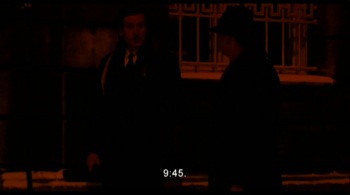
RJ: Yeah, well actually, when I first saw the film, one of the things that made me sure that this was all very carefully thought out was that moment, because in the Polish woman’s story she says “when it’s 9:45 I’ll think it’s after midnight.” So when that guy walked by and asked what time it was, I knew immediately he was going to say “9:45,” and when he said it I was like “aha!” And then at the end with the homeless women, the black woman and the Japanese woman, and the one on the left says “what time is it?” I knew she was going to say “after midnight,” because it was the completion of the [Polish woman’s story]. So [when I saw the film] this third time I started to notice all kinds of things [like that]. There is nothing mentioned that doesn’t come back later in some way. Even if it doesn’t make any sense and you can’t figure out what it’s doing there…
DT: Yeah, a formal coherence at a very deep structural level.
RJ: Every single little thing comes back in some way or another at some point in the film.
DT: Another thing that struck me was the scene where the Polish version of the prostitute is sitting around with the elderly gypsies…
RJ: …and she disappears, and then the three others come forward and kind of arrange their chairs in the foreground of the frame, and then there’s a dissolve back to the rabbit set, and each one of those characters are in exactly the same position as the rabbits are coming through. I didn’t notice that last time actually, and that was beautiful.
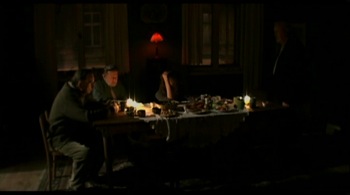
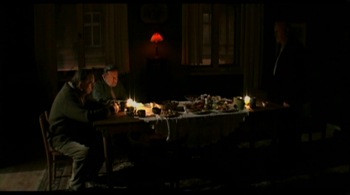
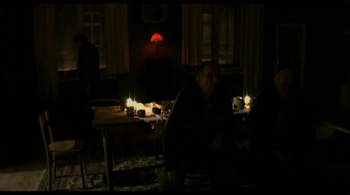
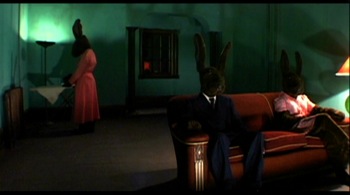
DT: So there’s a connection made between those characters maybe being aspects of the same Laura Dern. There are three rabbits, so maybe these reference the three Laura Dern characters.
And the thing I noticed after watching it today that was interesting is the scene where we first see, I call her the screwdriver woman.
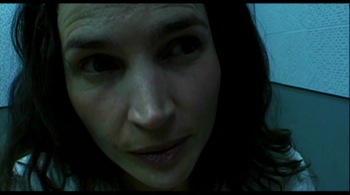
The first time we see her with the police, and she’s saying how she’s going to kill somebody and it’s revealed that she has the screwdriver stuck on her stomach, that scene cuts, and the very first word we hear in the following scene is the Devon character saying “my wife,” and that’s actually who she is. Later we learn that the screwdriver woman is Devon’s wife.
[At the end of the film,] when Laura Dern comes into the house [and confronts Justin Theroux and his wife], that scene there was actually a recreation of the Blue Velvet scene, where the Isabella Rosellini character reveals to Jeffrey “I love you” and Laura Dern slaps her. It’s very similar. She comes into the domestic scene and the husband is there and the wife comes up and slaps her.
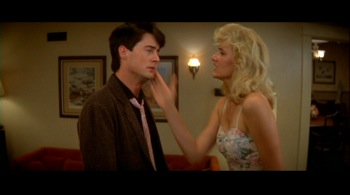
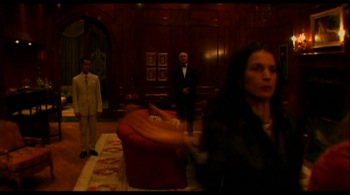
And that actress is the one who comes up and kills her with the screwdriver. But the first time you see her we think “who is this person?” But if you listen to the dialogue over that cut it actually tells us that it’s the wife of the Billy character. So at that point she’s in the Blue Tomorrows script. Interesting isn’t it?
And there are other moments of intertextuality [between Lynch’s films] too. [For example], in that scene [on the film set] where we get the loop where she’s in the space twice, [looking out at herself from behind the set], when she first comes out we see a shot of a black void and we see her walking out of the void, she’s out of focus and comes into focus, and that’s very similar to the very first time we see her character in Blue Velvet: she’s on the street and she walks out of this complete darkness.


That’s why when you see the film multiple times you get to see more of the puzzles [and connections]. It doesn’t make more sense in a holistic way, but it does in terms of how he makes some of the pieces fit. But the ultimate question would be, does that make it interesting or good?
RJ: I think it makes it good. [Laughs all around.] Like I said, if I didn’t enjoy it then I wouldn’t care. There are lots of good films that I don’t enjoy. This one happens to be a good film that I do enjoy. Or maybe because I enjoy it I’m blind to the fact that maybe it’s not so good, but you know, when thinking about teaching the Film Aesthetics class [at Concordia]…
DT: It’s perfect, formal coherence…
RJ: …it’s just like, you know, forget about if you like or dislike the film, you take a look at it, and if you can see how the filmmaker is drawing associations between things and start to imagine what their functions might be, the more of that you see going on, the more you can say that it’s a well-made film, it’s thought out, things are the way they’re supposed to be.
PR: Yeah, I mean most people would say that this film is too long. I actually would say the same thing. But I wouldn’t say that [Michael Snow’s] La Region Centrale is too long, which is the same length. I just think that the stuff I’m not really interested in goes on too long, and doesn’t necessarily have to be so prolonged. So like I say, I really appreciate the beginning and the end. And because it’s a three-hour film I could have done with a shorter middle. I’m not sure how necessary that length was in the middle, you know.
RJ: Well maybe when you see it again…
PR: [Laughs.] Yeah, when I see all these parallels and repetitions…
DT: The whole film is a mise-en-abime. The French love that. “C’est un mise-en-abime ca!”
[More laughs all around.]



